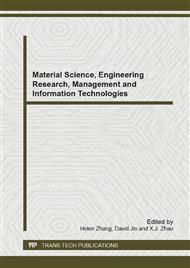[1]
Jieqing Jia, Air conditioning energy consumption diagnosis and fault diagnosis system (utility) method,Handan:Hebei University of Engineering (2011).
Google Scholar
[2]
Qiuping Yu, Study on the influence factors of energy consumption of typical office building in Shanghai and its application in LEED standard, Shanghai:Donghua University(2011).
Google Scholar
[3]
K. Kircher,X. Shi,S. Patil et al. Cleanroom energy efficiency strategies: Modeling and simulation[J]. Energy and buildings, 2010, 42(3): 282~287.
DOI: 10.1016/j.enbuild.2009.09.004
Google Scholar
[4]
Jing Zhao, Large public buildings energy-saving diagnosis and technical system of evaluation research , Tianjin:Tianjin University(2009).
Google Scholar
[1]
(If square brackets are not available, slashes may be used instead, e. g. /2/. ) Two or more references at a time may be put in one set of brackets [3, 4]. The references are to be numbered in the order in which they are cited in the text and are to be listed at the end of the contribution under a heading References, see our example below. Summary If you follow the checklist, your paper will conform to the requirements of the publisher and facilitate a problem-free publication process. References.
Google Scholar
[1]
Dj.M. Maric, P.F. Meier and S.K. Estreicher: Mater. Sci. Forum Vol. 83-87 (1992), p.119.
Google Scholar
[2]
M.A. Green: High Efficiency Silicon Solar Cells (Trans Tech Publications, Switzerland 1987).
Google Scholar
[3]
Y. Mishing, in: Diffusion Processes in Advanced Technological Materials, edtied by D. Gupta Noyes Publications/William Andrew Publising, Norwich, NY (2004), in press.
Google Scholar
[4]
G. Henkelman, G. Johannesson and H. Jónsson, in: Theoretical Methods in Condencsed Phase Chemistry, edited by S.D. Schwartz, volume 5 of Progress in Theoretical Chemistry and Physics, chapter, 10, Kluwer Academic Publishers (2000).
Google Scholar
[5]
R.J. Ong, J.T. Dawley and P.G. Clem: submitted to Journal of Materials Research (2003).
Google Scholar
[6]
P.G. Clem, M. Rodriguez, J.A. Voigt and C.S. Ashley, U.S. Patent 6, 231, 666. (2001).
Google Scholar
[7]
Information on http: /www. weld. labs. gov. cn.
Google Scholar


